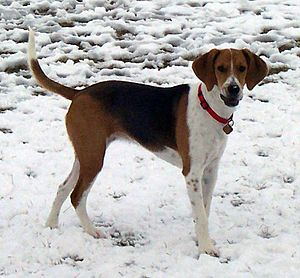Harrier (dog) facts for kids

A tri-colour Harrier
|
||||||||
| Origin | United Kingdom | |||||||
|---|---|---|---|---|---|---|---|---|
|
||||||||
| Domestic dog (Canis lupus familiaris) | ||||||||
The Harrier is a medium-sized dog breed. It belongs to the hound family, which means it's a type of dog often used for hunting. Harriers are especially good at tracking and hunting hares. They look a bit like a smaller English Foxhound but are larger than a Beagle. People have been using this breed for hunting since the 1200s!
Contents
What Does a Harrier Look Like?
Size and Build
Harriers are similar to the English Foxhound, but they are smaller. They usually stand about 19 to 21 inches tall at the shoulder. Adult Harriers typically weigh between 45 and 65 pounds. They are strong and muscular hunting dogs.
Coat and Features
Harriers have short, hard coats that shed. They come in many different color patterns. They have hanging, rounded ears and a broad skull. Their muzzle is strong and square-shaped. Harriers have brown or hazel eyes and a wide black nose. When relaxed, their expression is calm, but they look alert when excited. Their tail is medium-length and carried high. Their feet are neat and "cat-like."
What is a Harrier's Personality Like?
Temperament and Behavior
Harriers are known for being cheerful and sweet-tempered dogs. They are very tolerant of people and are excellent with children. Since they are "pack dogs," they usually get along well with other dogs. If they are raised with other non-dog pets from a young age, they can also get along with them.
Activity Levels
Harriers love being part of a pack, whether it's with people, other dogs, or both! They are very active dogs who enjoy exploring, sniffing, and tracking scents. Because of their strong hunting instincts, it's important to keep them on a leash or in a safe, enclosed area when outside. Some Harriers also like to "bay," which is a type of bark or howl.
How Long Do Harriers Live?
Health and Lifespan
Harriers generally live for about 12 to 15 years. Like some other dog breeds, they can sometimes have a condition called hip dysplasia. This is a problem with their hip joints.
How to Care for a Harrier
Grooming Needs
Harriers have short coats that are easy to care for. They only need occasional brushing to remove any loose or dead hair.
Exercise Requirements
Harriers need a lot of exercise every day. This could be long, energetic walks or runs. If they don't get enough exercise, Harriers can become very hyperactive. They might also gain too much weight or become destructive. These dogs were bred to run and work all day, so they can't just sit around. However, they can adapt well to a typical family home if they get enough activity.
The History of the Harrier Breed
Origins of the Breed
There are different stories about where the Harrier breed came from. Some say early Harriers were mixed with Bloodhounds, the Talbot Hound, and even the Basset Hound. Other stories suggest they were developed from crosses between the English Foxhound, Fox Terrier, and Greyhound. Another idea is that the Harrier is simply a smaller version of the English Foxhound. Even though there are many working Harriers in England, the breed is not officially recognized there.
Hunting Hares and Foxes
Today's Harrier is a size between the Beagle and the English Foxhound. They were mainly developed to hunt hares, which is why they are called "Harriers." However, some packs also use them for fox hunting. The Harrier has a long history of being a popular working pack dog in England.
Harriers in Ireland and America
In Ireland, Harriers are the most common type of hound used by hunting groups. There are many Harrier packs across the country, some that hunt on horseback and others that hunt on foot. In Ireland, they often hunt both foxes and hares. The American Kennel Club officially recognized the Harrier breed in 1885. They are classified in the Hound Group. The earliest known description of a Harrier comes from a book called "The Chace," written in 1735 by William Somervile.

